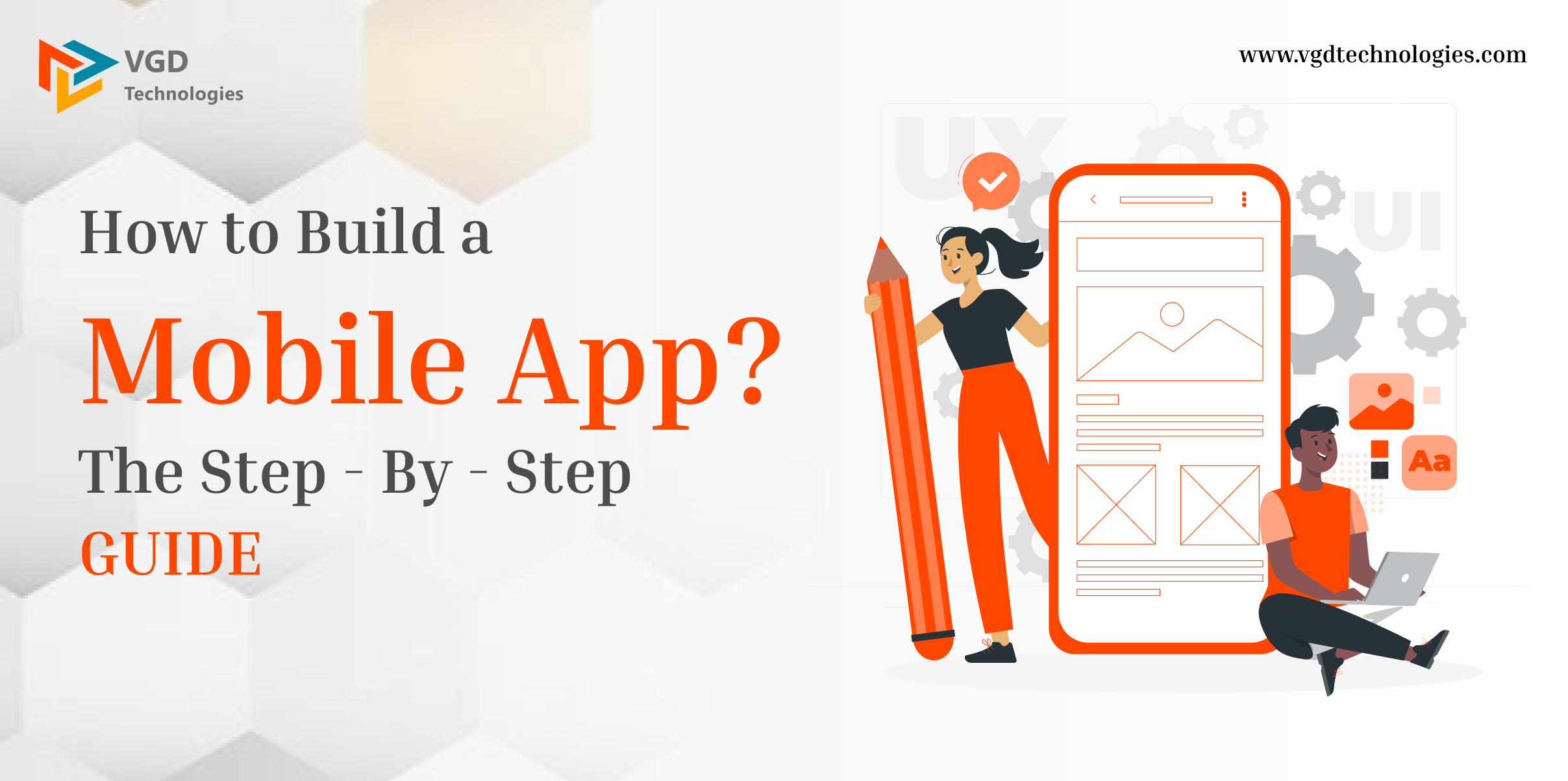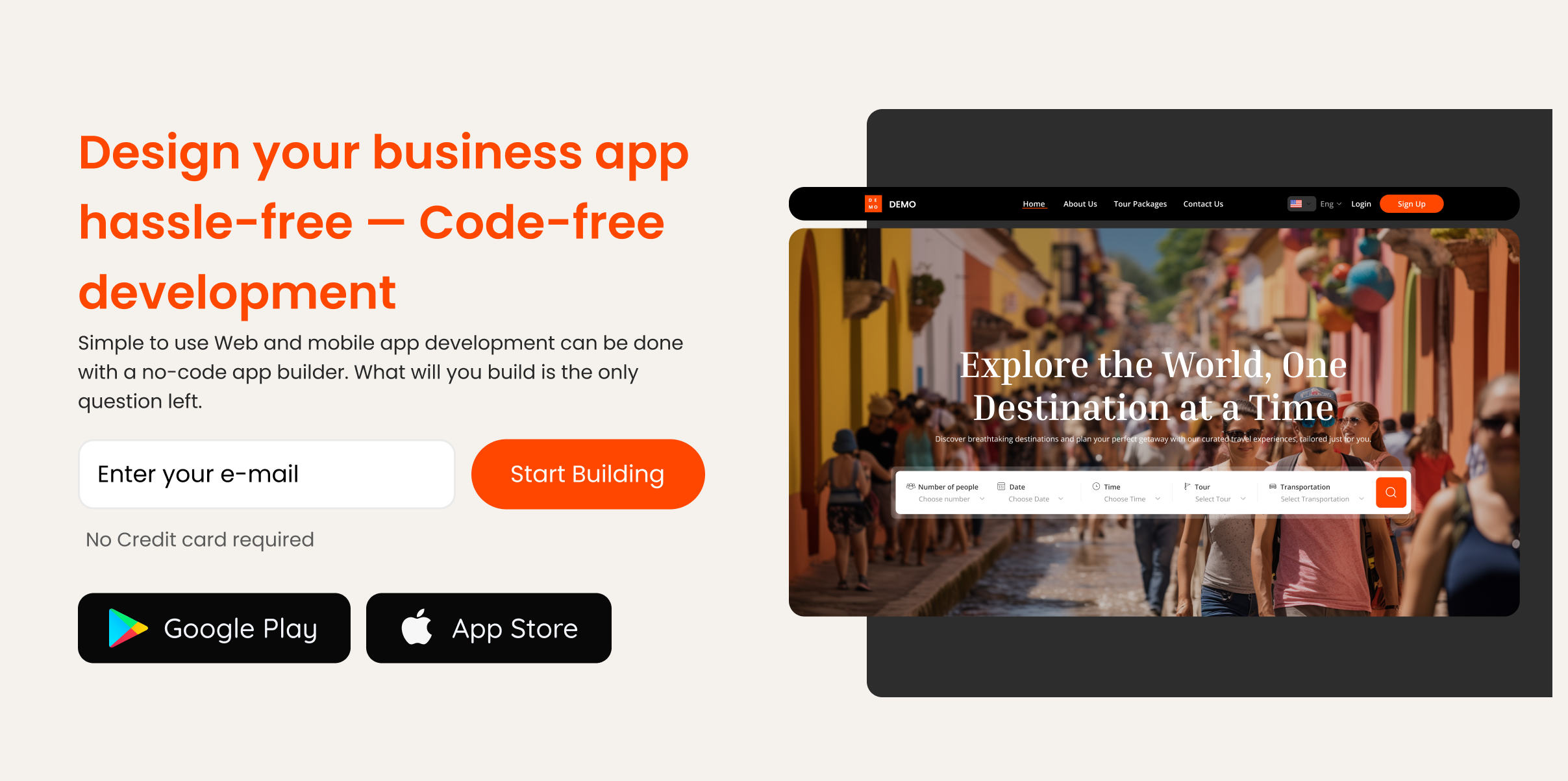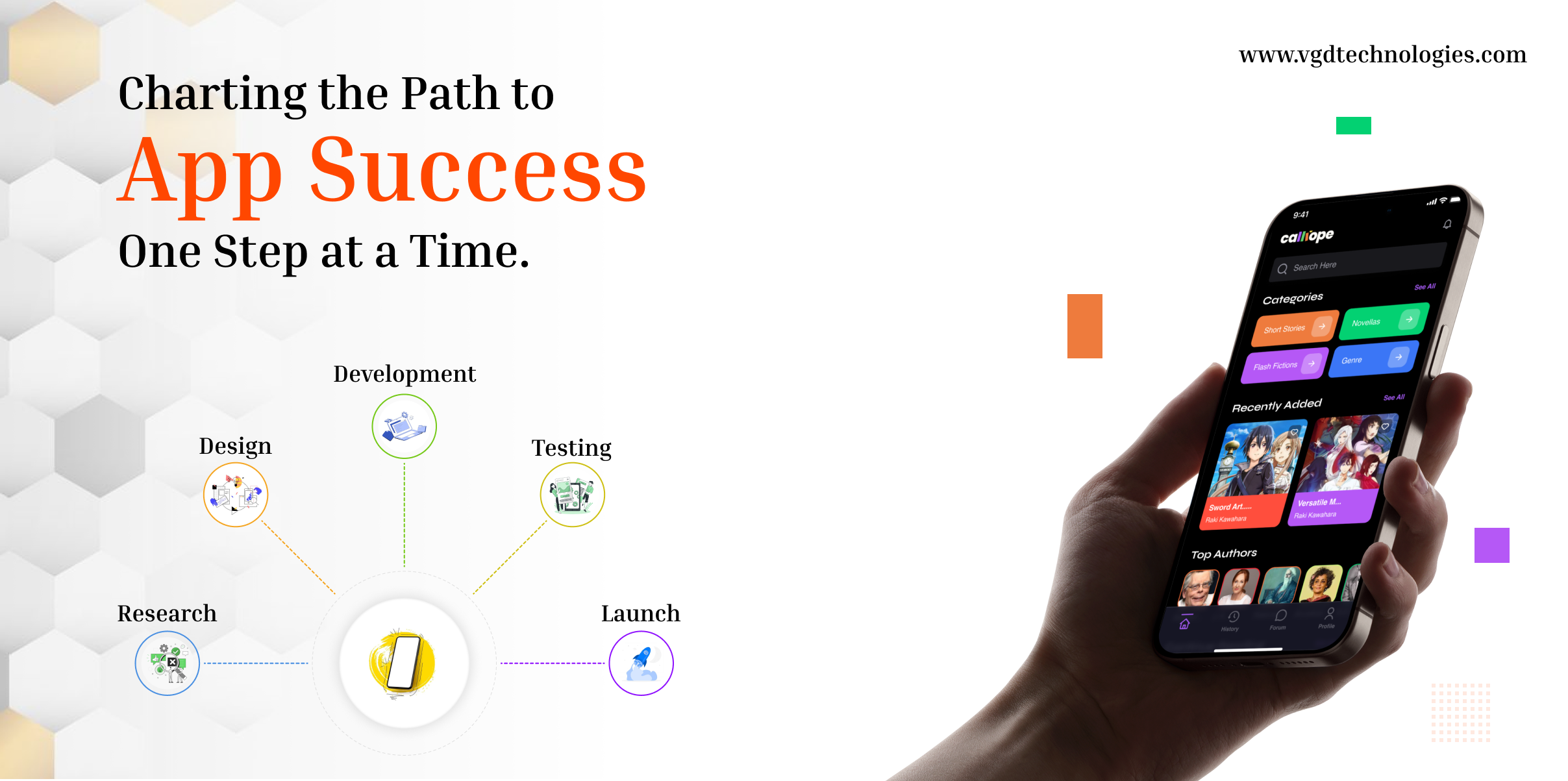How to Build a Mobile App?
To create a mobile app, you need a unique project idea, technical expertise, dedicated time, and strong motivations. Here are five compelling reasons to consider when asking yourself, “How can I make a mobile app?”
-
Enhance brand visibility and reputation.
-
Provide tailored features for your customers.
-
Generate interactions that align with your business objectives.
-
Leverage the widespread use of mobile devices.
-
Improve the speed and quality of user interactions.
We’re on a mission to build a better future where technology creates good jobs for everyone. Duis autem vel eum iriure dolor in hendrerit in vulputate velit esse moles dolore eu feugiat..
Whether you aim to create an app that complements your website, attract a new audience, or bring an innovative idea to life, this guide will walk you through the essential steps to make an app from scratch. We will cover everything from your initial app idea to publishing it in app stores and ongoing maintenance, ensuring you have an easy-to-follow resource for beginners looking to understand how to create an application.
7 Tips on How to Make an App
-
Get your app idea on paper: The mobile app market is highly competitive, with an estimated 258 billion downloads projected by 2023. Defining your app concept is crucial. Identify your target audience, desirable features, and analyze competitors to refine your idea.
-
Build a Native App or a PWA: Choose between a native app or a Progressive Web App (PWA) based on your business needs.
-
Select the Best Development Method: Decide how to create your app, whether through coding or using an app builder (no-code option).
-
Test on iOS and Android: Ensure your app functions well across both platforms.
-
Submit and Publish: Once testing is complete, publish your app on relevant app stores.
-
Continuous Improvement: Regularly update and improve your app based on user feedback.
-
Plan Your App Design: An engaging user interface (UI) and user experience (UX) are vital. Focus on visual simplicity and familiar layouts to retain users. Sketch wireframes to prioritize essential features before diving into detailed design.
By following these steps, you will have a comprehensive understanding of how to create an app that resonates with users and meets business goals. With the right preparation and execution, you'll be well on your way to successfully launching your mobile application.
How to Make an Application: Choosing the Right Development Approach
When it comes to how to develop an app, you have several approaches to consider, each with its pros and cons. The two main types of app development are Native apps and Progressive Web Apps (PWAs).
Native App Development
A native mobile app is designed specifically for a particular operating system, such as Apple's iOS or Google's Android. Native apps excel in performance because they utilize the device's hardware and software resources effectively. This method is ideal if you want to ensure a high-quality user experience, as it allows access to a wide range of native APIs and features.
In the past decade, the Apple App Store has grown from 500 to nearly 2 million apps, while Google Play Store offers about 2.4 million apps. Native apps currently account for over 80% of all mobile traffic. If you're exploring how to make an app for free, however, keep in mind that developing native apps requires extensive coding skills and can be time-consuming and costly.
Progressive Web App (PWA)
On the other hand, a Progressive Web App (PWA) combines the best features of web pages and mobile apps. PWAs offer a similar experience to native apps without needing to go through the app store publication process. They can be installed on a user's home screen and adapt seamlessly across devices, including mobile, tablets, and desktops. Notably, PWAs benefit from SEO and are indexed by search engines, allowing for greater visibility.
However, while a PWA can attract three times more visitors than a native app, its feature availability may depend on the browser being used. For businesses focused on a mobile presence, PWAs are an excellent option, especially since 67% of web traffic comes from mobile devices.
Choosing the Right Method to Build an App

Once you've determined whether to create a native app or a PWA, it’s time to decide how to build an app effectively. Here are three main methods to consider:
- Develop Your Own App: If you’re interested in how do you make an app for free, building your own app is a viable option. This requires coding skills in languages such as Swift or Objective-C for iOS and Java or Kotlin for Android. While this approach demands a significant time investment and technical expertise, it allows for complete customization.
- Hire an Agency or Freelance Developer: If budget allows, hiring a development agency or a freelance developer can bring your app vision to life without compromising on quality. This method is generally the most expensive but ensures professional results
- Use an App Builder: App builders are no-code platforms that let you create mobile apps without any programming knowledge. These tools often feature a drag-and-drop interface, enabling users to visualize their app in real-time. This is a cost-effective solution for many and can save both time and resources, although it may not be suitable for highly complex projects.
By evaluating these methods, you’ll be well-equipped to make informed decisions on how to make an application that meets your business needs and goals.
Choosing the Right Method to Build an App

Now that you’ve made your key decisions, it’s time to dive into the app creation process. If you’re exploring how to develop an app using a no-code development platform, VGD Technologies is a fantastic option.
With over 10 years of experience in app development, VGD Technologies enables you to create an app that functions seamlessly on both iOS and Android devices, as well as as a Progressive Web App (PWA) — all from a single interface.
Design Your App
When considering how to build an app, design plays a critical role. You'll need to decide on your app’s overall color theme, header style, navigation options, icons for app stores, and splash screens. Aligning your design with your existing brand elements—such as logos, colors, and fonts—ensures a cohesive look.
The home page is crucial as it will be the most visited part of your app. It should highlight your key features and provide easy navigation using the widgets offered by VGD Technologies. With our Preview feature, you can instantly see the look and feel of your app as you design it.
Add Content
Next, it’s time to add content that conveys your business message. You can enter this content manually into your app’s backend or integrate existing content from sources like RSS feeds or social media accounts. VGD Technologies organizes your app’s structure into sections—like articles, videos, and maps—keeping navigation straightforward and user-friendly.
Enhance with Add-ons
VGD Technologies also offers a variety of add-ons to enhance your app's functionality. For instance, if you're developing an app for a retail business, consider using the Loyalty Card and Couponing Add-ons to keep customers engaged. Push notifications can inform users about new products and events. If your app serves a community or internal communications, Chat and Community Add-ons can foster user engagement and interaction.
Customization and API Access
If you need specific features, explore the customization options available on our platform. You can also activate API access, which allows your app to communicate with other software for enhanced functionality.
Testing Your App
After assembling your app (concept, design, and technology), it’s time to
test it thoroughly.
Ensure you check the app’s performance across different operating
systems and browsers.
Recruit beta testers to gain insights on usability and functionality.
For iOS apps, consider using TestFlight for testing prior to submission
Submit and Publish Your App
Once your app is ready, it’s time to publish it. It’s advisable to release your app on multiple platforms to maximize user reach. Registering as a developer is the first step; Apple charges $99 annually for the Developer Program, while Google has a one-time fee of $25.
Apple App Store: Submission involves preparing app icons, previews, and metadata. Apple conducts a review before approval, ensuring all guidelines are met.
Google Play Store: After registering your app on the Google Play Console, provide essential details and upload your APK file for review. Google typically approves apps quickly but can take longer for new developers.
Progressive Web App: Publishing a PWA is simpler—just host it on a web server and link a domain. This ease allows you to focus on optimizing your SEO for better visibility.
Continuous Improvement
Finally, to keep your app relevant, regularly update it with new features and content. Monitor user feedback and app performance using analytics tools from Google Play and the App Store.
Ensure your users are aware of updates through push notifications or by showcasing new features prominently. You can update your app frequently, while PWAs can be modified without resubmission constraints.
VGD Technologies recommends making updates 3 to 4 times a year to introduce new features, fix bugs, and adapt to OS updates. Our team is here to guide you through the update process and keep you informed about necessary changes.
By following these steps, you'll be well on your way to successfully making an application that stands out and meets the needs of your users!
How to Create an App on Your Own
If you're interested in how to create an app independently, understanding the key programming languages and skills needed for app development is essential. This guide covers the most popular languages and frameworks used for building various types of apps: native, hybrid, and web.
-
Build a Native App
- Programming Languages: The primary language for iOS development is Objective-C, but Apple has introduced Swift, which is easier to learn and offers better performance. Swift is increasingly becoming the go-to language for iOS apps.
- Development Environment: iOS apps must be developed using Xcode, which is only available on macOS. You’ll also need to pay $99 annually to publish on the App Store.
- Popular Languages: Java remains the most widely used language for Android development due to its integration with Google's tools. Kotlin, recently adopted by Google, is gaining popularity and is compatible with Java.
- Other Options: For lower-level access, you can use C or C++, but they require additional components and are less common for standard app development. C# can be used via Xamarin, which allows you to create apps with Visual Studio.
-
Create a Progressive Web App (PWA)
Native apps for iOS (Apple) and Android are available exclusively on their respective stores—App Store and Google Play Store.
Creating an iOS App
Creating an Android App
A PWA is a web application that runs on any operating system via a browser, using "Service Workers" to enhance functionality. PWAs are lightweight, easy to update, and don't require app store submission, but they do require an internet connection to function.
You can build PWAs using JavaScript, which offers a middle ground between traditional web languages and native app capabilities.
App Creation Help: Questions & Answers
How to Create an App for Free? With VGD Technologies, you can create an app for free during a one-month trial period. Build a native app for Android or iOS, or a PWA, without upfront costs.
How Much Does It Cost to Make an App? The cost varies based on:
- ● Technology: Native vs. web apps, etc.
- ● Features: More complex functionalities increase costs.
- ● Design: Custom designs can be more expensive.
- ● Deployment: Marketing and app store submission fees also factor in
How Long Does It Take to Build an App? On average, it takes about 18 weeks to develop a mobile app, depending on complexity. However, using an app builder like VGD Technologies can reduce this time significantly.
Can I Create an App by Myself? Yes, but you’ll need to learn programming languages if you want to code from scratch. If you're not ready to dive into coding, consider using a no-code app builder for a more straightforward approach.
What Kind of Apps Are Most Popular? On-demand service apps are trending, including those for video streaming, food delivery, logistics, and healthcare.
Conclusion
Creating an app is a multifaceted process that requires careful planning and decision-making. Begin by defining your app’s purpose and design, then choose whether to build it on your own, hire a developer, or use a no-code app builder like VGD Technologies. Remember, technical skills combined with marketing knowledge are crucial for success in the app marketplace.
With VGD Technologies, you have the support needed to bring your app ideas to life!

